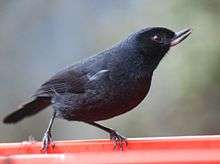Flowerpiercer
Diglossa is a genus in the family Thraupidae. They form a group known as flowerpiercers because of their habit of piercing the base of flowers to access nectar that otherwise would be out of reach. This is done with their highly modified bill. Most members of the genus Diglossa are found in highlands of South America (especially the Andes), but two species are found in Central America.
Diglossa sittoides or Rusty flowerpiercer, female, piercing the base of an Abutilon flower to access the nectar inside.
| Diglossa | |
|---|---|
 | |
| Glossy flowerpiercer (D. lafresnayii) | |
| Scientific classification | |
| Kingdom: | Animalia |
| Phylum: | Chordata |
| Class: | Aves |
| Order: | Passeriformes |
| Family: | Thraupidae |
| Genus: | Diglossa Wagler, 1832 |
| Species | |
|
About 14, see text | |
Species list
- Cinnamon-bellied flowerpiercer, Diglossa baritula
- Slaty flowerpiercer, Diglossa plumbea
- Rusty flowerpiercer, Diglossa sittoides
- Venezuelan flowerpiercer, Diglossa venezuelensis
- Chestnut-bellied flowerpiercer, Diglossa gloriosissima
- White-sided flowerpiercer, Diglossa albilatera
- Glossy flowerpiercer, Diglossa lafresnayii
- Moustached flowerpiercer, Diglossa mystacalis
- Mérida flowerpiercer, Diglossa gloriosa
- Black flowerpiercer, Diglossa humeralis
- Black-throated flowerpiercer, Diglossa brunneiventris
- Grey-bellied flowerpiercer, Diglossa carbonaria
- Scaled flowerpiercer, Diglossa duidae
- Greater flowerpiercer, Diglossa major
- Indigo flowerpiercer, Diglossa indigotica
- Deep-blue flowerpiercer, Diglossa glauca
- Bluish flowerpiercer, Diglossa caerulescens
- Masked flowerpiercer, Diglossa cyanea
gollark: ...
gollark: Are you sure? What laws is this actually based on?
gollark: You would certainly hope so.
gollark: The RTC is still on.
gollark: Even a "turned off" one is still going to have a few things running, so it can detect the power button and possibly do wake-on-LAN.
References
- Mauck, & Burns (2009). Phylogeny, biogeography, and recurrent evolution of divergent bill types in the nectar-stealing flowerpiercers (Thraupini: Diglossa and Diglossopis). Biological Journal of the Linnean Society 98 (1): 14–28.
- Ridgely, R. S., & Tudor, G. (1989). Birds of South America. Vol. 1. Oxford University Press, Oxford. ISBN 0-19-857217-4
This article is issued from Wikipedia. The text is licensed under Creative Commons - Attribution - Sharealike. Additional terms may apply for the media files.